![]()
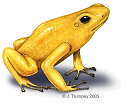
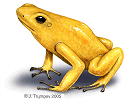 BATRACHOTOXIN
BATRACHOTOXIN![]()
Simon Cotton
Uppingham School, Rutland, UK
![]()
Also available: HTML-only, JMol, and VRML versions.
![]()
 Inner city gang violence?
Inner city gang violence?No, a frog in a tropical rainforest.

When touched or threatened, tiny poisonous frogs in the jungles of Western Colombia produce venom from glands on their backs and from behind their ears. Native Indians have used this venom for hundreds of years to poison blow darts (see photo, right, of an Emberá Chocó of Colombia hunting with batrachotoxin-tipped darts from a blowpipe).
Handling one of these frogs could kill you, if the toxin were able to enter through a cut in your skin.
It's said that they stick the frog on a piece of wood, then hold the frog over a fire. The toxin is "sweated out" and collected.
It was discovered in the 1960s that these frogs - golden Phyllobates terribilis and multicoloured Phyllobates bicolor - contain substances such as batrachotoxin and homobatrachotoxin. They are among the most toxic substances known, more toxic than curare or the tetrodotoxin, used by the puffer fish (itself over 1000 times more poisonous than cyanide). Other frogs use different poisons, but none as toxic as batrachotoxin.
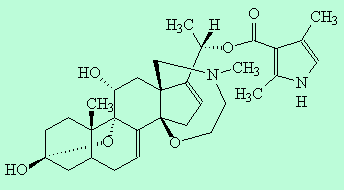 |
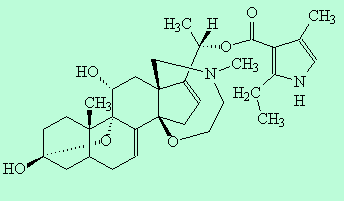 |
It's made up of two Greek words; batrachos (βάτραχος) is frog in Greek, plus toxin (τοξίνη) which is poison in Greek.
Around 136 μg is the lethal dose for a person weighing 150 pounds; that is, about two grains of table salt. On average one frog packs 1100 μg of batrachotoxin.
Small but deadly, at most a couple of inches long, and weighing a few grams.
The batrachotoxin increases the permeability of the outer membrane of nerve and muscle cells to sodium ions. Thus it stops these channels within muscle fibres from closing normally, allowing a big inflow of sodium ions into the cell. This causes an irreversible electrical depolarisation, blocking the nerve signals that would normally cause the muscle to relax, the muscle remaining contracted. Certain cells within the heart are very sensitive to this, resulting in heart arrythmias, fibrillation and ultimately cardiac failure.
It seems that they have a modified sodium channel protein in their nerves and muscles, so the batrachotoxin cannot bind to a receptor.
 Captive-born Phyllobates terribilis don't have batrachotoxins in their skins; if poison frogs are caught in the wild, the amount of toxin in their skin often diminishes with keeping. This suggests a dietary origin for the toxin.
Captive-born Phyllobates terribilis don't have batrachotoxins in their skins; if poison frogs are caught in the wild, the amount of toxin in their skin often diminishes with keeping. This suggests a dietary origin for the toxin.
In 1989, an American ornithologist called Jack Dumbacher was doing his graduate studies in Papua New Guinea. One day, he was freeing a Pitohui bird (a native songbird about the size of a jay) from a net, when his hand was bitten and scratched by the bird. Instinctively he put his hand in his mouth and found it tingled and started to go numb. Intrigued by this, he eventually passed samples of the plumage to John W. Daly, the world expert of the chemistry of the substances secreted by poison dart frogs, who identified the presence of batrachotoxin. The natives of New Guinea have long known that these birds were inedible. More recently, batrachotoxins have been found in the feathers of another New Guinea bird, Ifrita kowaldi).
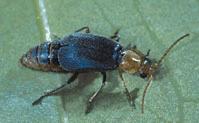 In 2004, it was reported that Melyrid beetles (Choresine), known to contain large amounts of batrachotoxin, were found in the stomach of Pitohui birds in New Guinea. These beetles are also found in Colombia, so they may form part of the diet of both the birds and the frogs.
In 2004, it was reported that Melyrid beetles (Choresine), known to contain large amounts of batrachotoxin, were found in the stomach of Pitohui birds in New Guinea. These beetles are also found in Colombia, so they may form part of the diet of both the birds and the frogs.
Whether the beetles make the batrachotoxin themselves or obtain it from their diet is not at present known. It would be unusual for a beetle to synthesise steroid molecules like batrachotoxin; it may be that the beetle gets it from small arthropods it eats, or maybe from plants.
However, it looks as if some frogs make their own alkaloids; Australian myobatrachid frogs of the genus Pseudophryne contain two types of alkaloids in their skin extracts, pseudophrynamines (PSs) and pumiliotoxins (PTXs). It seems that they biosynthesise the PSs (which are only found in these frogs), but get the PTXs from their diet (formicine ants).
Pretty essential, if you are a frog that doesn't want to be eaten by a predator; some snakes are resistant (but not immune) to the batrachotoxin though. Scientists are using these molecules to study the way in which nervous impulses are transmitted in animals. They are being studied for possible applications in areas like heart drugs and anaesthetics.
These poisonous frogs use a very wide range of substances of hitherto undreamed-of structures as venoms. Goodness knows what other amazing chemicals lie in wait in the rainforests, each a potential medicine. If that isn't a good argument for conservation, I don't know what is.
![]()